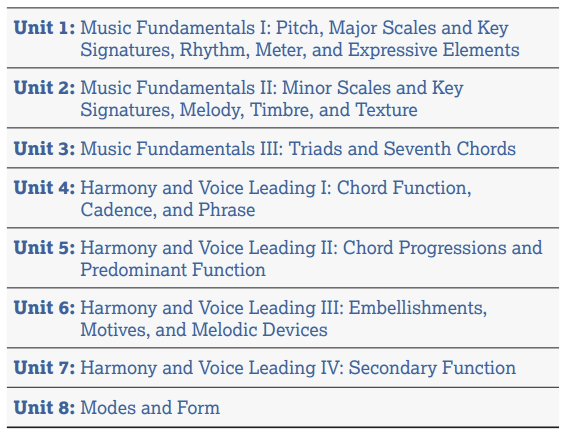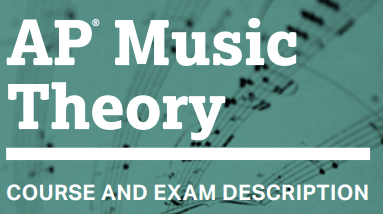Last Updated on March 27, 2025
AP Music Theory Practice Test 2025 Official Study Guide [PDF]: Try The College Board’s Advanced Placement (AP) Music Theory exam questions and answers with printable PDF for free. You can also download the AP Music Theory Practice Test with multiple-choice questions and answers.
Advanced Placement (AP) Music Theory (or AP Music or AP Theory) is a course and examination offered in the United States by the College Board as part of the Advanced Placement Program to high school students who wish to earn credit for a college-level music theory course.
AP Music Theory Practice Test 2025
The following AP Music Theory Practice Test consists of 25 to 30 multiple-choice questions. There are eight units. You can test your AP Music Theory knowledge through free unit-wise practice tests. This will help your AP Music Theory Exam prep.
- AP Music Theory UNIT 1 Practice Test
- AP Music Theory UNIT 2 Practice Test
- AP Music Theory UNIT 3 Practice Test
- AP Music Theory UNIT 4 Practice Test
AP Music Theory Exam
The Advanced Placement (AP) Music Theory exam has two parts: Multiple- Choice and Free-Response sections.
Section I:
- Part A (32–34 questions, 35 minutes) (Questions based on analysis of printed music scores) is multiple-choice questions based on recorded music. Part A questions are at varying difficulty levels and range from identifying scale patterns and chord quality to listening to musical excerpts of various styles that test your listening skills in form, texture, harmonic progression, or error detection.
- Part B: (41–43 questions, ~45 minutes) Questions based on aural stimulus are non-aural multiple-choice. Part B is the fundamentals of music, focusing on terminology and visual score study and analysis.

Section II:
Part A ( 7 questions ~ 1hr 10mins 45% of Score) consists of answering 7 questions in 60 minutes. It is worth an additional 45 percent of the exam. The first 4 free-response questions are also based on recorded music.
- Free-response 1 and 2 (FR 1, 2) are melodic dictations that require you to listen to a short melody and notate pitch and rhythm accurately on the staff.
- Free-response 3 and 4 (FR 3, 4) are harmonic dictations that require you to listen to a short four-part chorale and notate the soprano and bass. You must also write the Roman numeral chord symbols, including appropriate progression inversions.
- FR 5 is realizing figured bass, where you will be required to write a melody as well as the alto and tenor above a given bass line with figures and give the Roman numeral chord symbols.
- FR 6 is part-writing from Roman numerals, where you will be required to write all four voices from the given Roman numeral chord progression.
- FR 7 harmonizes a melody by writing an appropriate bass line and indicating harmonic structure and cadences using chord symbols.
Part B (2 questions ~ 10mins 10% of Score)
: Sight-singing is an individually administered sight-singing portion that consists of 2 melodies to be performed and recorded and constitutes 10 percent of the exam. You will have 75 seconds to practice each melody, fol¬ lowed by 30 seconds to record your performance of the melody. These terms are clues. Use them to your advantage. Here are some other helpful hints
- Read the questions twice.
- Underline or circle important words, such as those just mentioned, to help narrow your choices and keep you focused on the requested task.
- Keep in mind that there is no deduction for an incorrect answer. So, even if you have no clue, take a chance and guess.
- If you can narrow down the answers by eliminating one or more of the responses, then, by all means, guess!
Exam Content
Unit 1: Music Fundamentals I: Pitch, Major Scales and Key Signatures, Rhythm, Meter, and Expressive Elements
Unit 2: Music Fundamentals II: Minor Scales and Key Signatures, Melody, Timbre, and Texture
Unit 3: Music Fundamentals III: Triads and Seventh Chords
Unit 4: Harmony and Voice Leading I: Chord Function, Cadence, and Phrase
Unit 5: Harmony and Voice Leading II: Chord Progressions and Predominant Function
Unit 6: Harmony and Voice Leading III: Embellishments, Motives, and Melodic Devices
Unit 7: Harmony and Voice Leading IV: Secondary Function
Unit 8: Modes and Form
How the Test is Graded?
The multiple-choice and free-response sections are designed to measure a wide range of music skills. The five-point scoring system is standard among all the AP exams:
- A grade of 5 = Extremely Well Qualified. Almost all colleges and universities accept this score.
- A grade of 4 = Well Qualified. Accepted by most colleges and universities.
- A grade of 3 = Qualified. Accepted by many colleges and universities.
- A grade of 2 = Possibly Qualified. Accepted by a few colleges and universities.
- A grade of 1 = No Recommendation. Not accepted.
Your score from 1 (low) to 5 (high) on this exam will consider your performance in both sections. A passing grade of 3 (qualified) will be a composite score, which many colleges and universities accept. However, some universities consider the section subscores individually, not just the composite, and look for a minimum score of 3 on both parts. Therefore, if you earn a 2 on the aural section and a four on the non-aural (for a composite score of 3), it is possible not to receive college credit.
Professionals from all over the United States, both high school teachers and college professors, gather for seven days of test grading known as AP Reading. The seven free-response questions and two sight-singing examples must be individually scored for this one week of intensive grading. A different reader grades each free-response question, so each question is an opportunity for a fresh start. More than 130 graders use the leadership team’s standards as scoring guidelines.
All graders are supervised, diligently checked and cross-checked for grading consistency. Even the supervisors are monitored to ensure grading quality across the spectrum. This checking and rechecking has made the AP Music Theory exam one of the most reliable Advanced Placement exams for scoring consistency.

